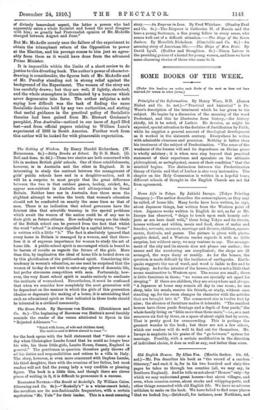Old _English Houses. By Allan Fes. (Martin Seeker. 10s. 6d.
net.)—Mr. Fea describes his book as "the record of a random itinerary," and such it is, for in his two hundred and sixty-five pages he takes us through ten counties (all, we may say, in Southern England). And he tells us not about "Houses" only—by which we may understand great houses—but about villages, and even, when occasion serves, about stocks and whipping-posts, and other things connected with old English life. We have no adverse criticism to make on the book. We have failed to find some places that we looked for,—Brickwall, for instance, near Northiam, and Littlecote. But Mr. Fea may have written about them elsewhere; in any case, there must be many omissions, for the wealth of England in this same item of old houses is very great, especially in the Home Counties. Anyhow, this is a pleasant book to read, and the illustrations are remarkably interesting.—A similar book is Untrodden English Ways, by Henry C. Shelley (Siegle, Hill, and Co., 7s. 61. net). Mr. Shelley goes further afield than Mr. Pea ; in his last paper ho even disregards his own limitation of " English," and describes Inveraray Castle, the seat of the Duke of Argyll. It is always pleasant to follow his guidance. He begins by a journey to Cornwall, where he pictures St. Ives in some detail, coming back by way of Devonshire and Bath, to which he gives a chapter. Hursley 'and John Keble, Oatlands Park— which is no more "untrodden " than Inveraray is " English "- " Poets' Corner," and " Bunhill Fields "—here again the epithet is scarcely appropriate—and various other places are described. The book is quite readable, and it really matters nothing what we are to call it.







































 Previous page
Previous page